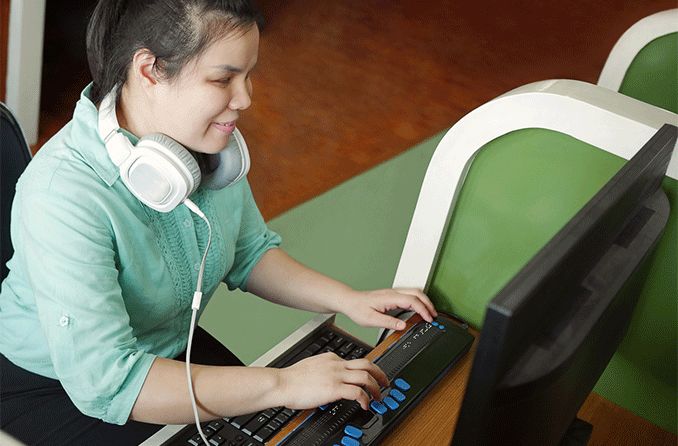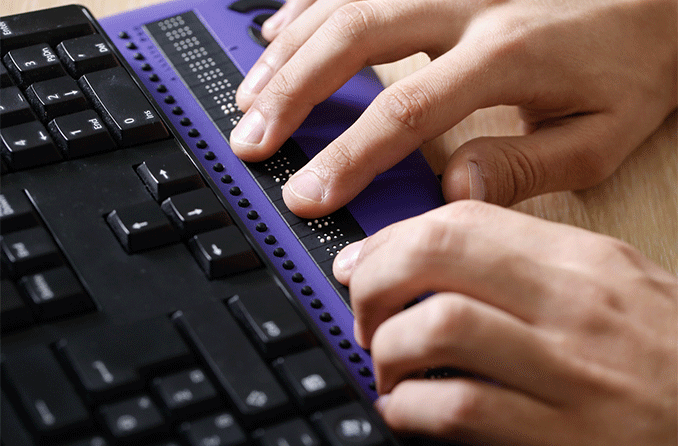Guide for Visually Impaired College Students


Justin Romack
Certified Professional in Accessibility Core Competencies, International Association of Accessibility Professionals
Starting college can be an intimidating experience for any prospective student. Picking classes, navigating the campus and gathering all the course materials can feel like a lot to juggle. Students with visual impairments have even more to consider to prepare them for that first day of class.
With the help of this guide, blind or visually impaired students can feel confident setting out on their academic journey.
Defining visual impairment
The American Foundation for the Blind explains visual impairment as a general term used to describe a spectrum of visual function. Someone who is visually impaired may experience low vision, complete blindness or be somewhere in between.
Where someone falls on the spectrum of visual impairment depends on their visual acuity — how clear or sharp their vision is.
Visual acuity is typically measured using the Snellen eye chart, which has several lines of letters. The largest letters begin at the top of the chart, then gradually become smaller as you move toward the bottom of the chart. Each line of the chart represents a level of visual acuity.
The average visual acuity for a person is 20/20, which, according to Prevent Blindness, means you can see most of the letters from the “20/20” line of the chart from 20 feet away. So, if a person has a visual acuity of 20/40, it means they must be 20 feet away to read something that a person with standard vision could see from 40 feet away.
The impact to a person’s visual acuity will place them in one of the categories of visual impairment: moderate, severe or profound.
Moderate visual impairment – Sometimes classified as “low vision,” moderate visual impairment describes people who have a visual acuity of 20/70 to 20/160 with corrective lenses. For perspective, imagine you are able to read a sign from 160 feet away. Someone with 20/160 vision would have to be 20 feet from that same sign in order to read it.
Severe visual impairment – To qualify as severely visually impaired (or “legally blind”), you must have a visual acuity of 20/200 to 20/400 or a visual field of 20 degrees or less. Your visual field is the area in which you’re able to see from your peripheral vision as you focus straight ahead. A typical visual field covers 120 horizontally and 90 degrees vertically.
Profound visual impairment – Having profound visual impairment means that your visual acuity is between 20/500 and 20/1000 or a visual field of 10 degrees or less. While someone who is profoundly visually impaired has very little vision, they have the ability to recognize different light sources, such as a lamp in a dark room. They can also differentiate between light and darkness, or daytime and nighttime.
Total blindness
Someone who is totally blind has no form perception or sense of light — a characteristic referred to as no light perception (NLP). Of those who make up the visually impaired community, only 15% of them are totally blind, making it a relatively rare condition.
Visually impaired students’ rights to an education
The Americans with Disabilities Act (ADA), as well as the Rehabilitation Act of 1973, are laws that ensure disabled people are given the resources they need to be successful in their public lives.
Disabled people are defined as those with physical or mental impairment that substantially limits one or more major life activities. These protected activities include education, training and employment.
Section 504 of the Rehabilitation Act protects disabled individuals from discrimination from any federally funded organization, including the U.S. Department of Education. This means college campuses are required to provide accommodations to students with disabilities, including access to:
Technology – Assistive technology that is needed for a visually impaired student to complete their coursework, such as an adaptive keyboard and a screen magnifier.
Information – Any knowledge that would help the student succeed in a particular class, including lectures, supplemental information or other course materials, should be made accessible.
Student services – All resources and services provided to sighted students (housing, transportation and health services, career counseling, etc.) should be offered and made accessible to visually impaired students.
In 2018, Times Union published an article about a prospective college student, Jason Camacho. Camacho filed lawsuits against nearly 50 colleges and universities because their websites did not accommodate the visually impaired, thus violating ADA.
Understanding your educational rights can empower self-advocacy and keep colleges accountable for a lack of inclusion.
Common obstacles faced by visually impaired students
On their website, Texas School for the Blind and Visually Impaired lists common difficulties identified among visually impaired students when they reach college. Several of these obstacles are also experienced by sighted students and part of the growing pains of adulthood. But many are critical to a visually impaired student’s success in and out of the classroom.
Orientation & Mobility
Navigating a college campus is overwhelming for a sighted student — for students who are visually impaired, it’s a significant obstacle.
Orientation & Mobility training can be done with an O&M specialist to help the student become familiar with navigating the campus — sometimes with the aid of a white cane or (in some circumstances) a guide dog. However, adjusting to a large, crowded and bustling environment can be challenging for visually impaired students.
Self advocacy with faculty and vocational counselors
Having a visual impairment likely means certain accommodations are needed to have the best chance of academic success. Schools often provide Disability Support Services with vocational counselors — sometimes referred to as access or accommodations coordinators — to advise students.
It’s up to the student to voice their concerns and establish their needs to their counselor, professor and whoever else influences their learning environment.
Some challenges faced by college students and amplified by visual impairment or blindness include:
Study skills, specifically writing papers
Ordering textbooks
Planning ahead and organizing notes
Social skills related to the college experience (roommates, etc.)
Intermediate to advanced computer skills
Daily life activities, including grocery shopping, laundry, etc.
Studying from an audio recording
Many schools for the blind, including Perkins School for the Blind, California School for the Blind and others, offer college prep programs to help students develop these skills before they apply for college.

How colleges and universities accommodate visually impaired students
Universal Design for Learning (UDL) is a teaching and learning system that combines a variety of teaching methods. Using UDL removes any learning barriers students may have and gives each of them an equal opportunity to learn.
Colleges and universities use UDL to accommodate visually impaired students by:
Assigning volunteers to help students read, take notes or perform other important tasks.
Using large fonts in lecture presentations, making auditory software available and providing braille materials.
Giving students extra time to get to class, complete assignments and finish tests.
Ensuring all campus facilities, including classrooms, dining halls and student housing, are fully accessible.
Allowing students to use alternative learning methods when giving presentations, completing assignments, etc.
Working with students to make sure they have what they need for academic success, such as assistive technology and adaptive software.
Types of assistive technology
Under the laws established by the ADA and Rehabilitation Act, postsecondary schools must offer assistive technology to students who need it. Most college campuses have an assistive technology center on campus that will provide students with one or more of the following aids for computer use:
Adaptive keyboard
There are a few different options for adaptive keyboards. Some may come with high-contrast keys to help low vision students see the letters better. If you’d prefer to adapt a regular keyboard, there are keyboard overlays with braille and locator dots on important keys that can easily be applied and removed.
Certain adaptive keyboards will come with word-completion software that can help improve typing speed with fewer keystrokes.
Braille display
This device sits underneath the keyboard and works by translating the words on the computer screen into braille. The user can then feel the braille with their fingertips and understand what’s being said on the screen.
A refreshable braille display is usually connected via USB or Bluetooth to provide braille feedback of text displayed on screen. It also works with screen-reading software like JAWS or VoiceOver.
These devices can include 20 or more braille cells. These cells use movable pins to change the characters being displayed as the reader scans their fingertips along the text. It then pans the display to the next section of text to be refreshed. A refreshable Braille display makes any digital text accessible in braille and is useful for blind students taking math or other STEM-based courses.
Braille embosser
Also called a braille printer, braille embossers take information from a computer and translate it into braille. From there, the braille is imprinted onto a piece of heavyweight paper and released from the printer, just as it would be when printed with ink.
Some Braille embossers are also capable of embossing line drawings to produce tactile graphics and printing ink to display print text alongside braille characters.
Braille translation software
Braille translators take documents and convert them into braille. The documents can then be printed with a braille embosser or read using a braille display. Duxbury (or DBT) is one of the most notable options in this kind of software.
Electronic notetakers
Also called portable notetakers, these devices store information that is computed using a braille keyboard or regular keyboard. The notetaker stores the information and can share it through a braille display or a built-in speech synthesizer.
As technology has advanced, many of these devices are running on a modified version of the Android operating system. They can install popular mobile applications to provide accessibility to a wide variety of tools like email, calendars, Amazon Kindle, and Facebook. Many notetakers can also be used in tandem with a desktop computer as a braille display.
Optical character recognition (OCR)
This system scans printed documents, recognizes the text and reads it back to the user. It also gives them the option to save the document as a computer file.
OCRs are sometimes capable of detecting misspelled words and notifying users of them. Although most OCR applications used by blind and VI individuals actually do not provide context for misrecognized words, but rather read them as they were recognized.
Additionally, many desktop OCR applications cannot yet interpret handwritten copy. However, Microsoft’s Seeing AI app on the iPhone can recognize handwritten text with a reasonable level of accuracy.
Screen magnification
This software is loaded into a computer’s memory and enlarges text and images on a computer screen. Similar to using a magnifying glass, you can move the cursor across the page and enlarge the area around it.
Users can also use a screen magnification app to change the contrast of text against the background (think white text on a black background). It can also change the size and color of the cursor so that it doesn’t “disappear” into the background of the display.
Screen reader
A screen reader is a software program that works with braille display and speech synthesizer to allow visually impaired students to read text that is displayed on a computer screen.
Most screen-reading applications also have on-demand speech feedback so blind and visually impaired people can avoid eye fatigue by having the app read aloud large blocks of text. One of the most popular magnification apps is called ZoomText, but Windows Magnifier and Apple Zoom on Mac OS and iOS are also very effective tools.
Video magnifier
A video magnifier uses closed-circuit television technology to magnify documents, books and other reading materials. This makes it easier for a person with low vision to read.
Video magnifiers, like screen magnification apps, can also adjust contrast and invert the text and background colors. Many video magnifiers include a feature for distance viewing. The camera can be pointed at a distant object, like a blackboard or projector screen, and the VI student has more flexible viewing of the displayed content.
Many popular models will also store screen captures and do OCR on content viewed through the video display.
SEE RELATED: Asking for an ADA accommodation at work

Planning ahead for college
College prep resources available through a school are an excellent means of getting a visually impaired student college ready. But not all students have access to similar programs. Some high school guidance and career counselors empower visually impaired students to establish an individualized plan for employment (IPE).
However, most of these counselors lack the knowledge and disability awareness to advise on matters of choosing an accessible college or transitioning successfully.
Blind and VI students should contact their state or regional vocational rehabilitation program and work with a team to determine what resources and pathways make the most sense for them. This team should consist of their school counselor, a Teacher of the Visually Impaired (TVI) and a Vocational Rehabilitation Counselor (VRC).
In line with the Rehabilitation Act of 1973, an IPE is a written plan, agreed upon by the counselor (or team) and the student. The plan outlines the educational or career-related goals of the student. It also details the resources that must be provided for them to meet those goals.
Once established, the IPE is reviewed annually by the student and a representative to determine whether changes need to be made.
If attending college is part of a student’s IPE, there are a few basic and important requirements they should establish. Then can use this as a checklist when deciding on a school.
Choosing the right school for you
There are many elements to consider when deciding where to get your college education, including:
Cost
Financial aid and scholarships
Degrees and programs offered
Format (online or in-person)
Campus size
Commute/distance from home
Campus resources and organizations
As a student with visual impairments, it’s also important to consider additional factors, such as:
Is the campus accessible?
How reliable is the school’s office of disability services?
Are the accommodations provided acceptable?
How many other visually impaired students are enrolled?
What organizations or resources are available to visually impaired students?
To find the answers to these questions, there are a few places you and your family can look.
Check the school website
Lawsuits filed against several schools for failing to meet ADA standards have driven colleges to establish their websites as the first impression of the schools’ accessibility. If a website for potential students isn’t accessible to the visually impaired, the promise for proper accessibility in other areas is low.
Schools with inclusive web content are more likely to be inclusive in other areas. Inclusive content may include the use of color contrast, text descriptions of visual aspects on the page and compatibility with assistive technology.
Talk to the disability services office
Before you take a trip to campus, call the disability services office of the school you’re interested in and ask to speak with the director or a counselor. Have a list of questions prepared (like the ones listed above). Include any questions you feel would make or break your decision to attend that particular school.
Most colleges and universities require students to register with the office before they’re eligible to receive accommodations. So speaking with the office is a good way to introduce yourself and get your questions answered. Based on your conversation with the office, you should have a good idea whether they can offer you the accommodations you want and need.
Visit the campus
If you’re planning to attend in-person classes, it’s important to tour campuses before deciding on a school. Working with an O&M specialist will foster independence as you become comfortable with your new surroundings.
It’s also recommended that you test out the environment before you commit to the school. Test the environment at different times of day. Explore the campus in the evening since darker or night-time travel can be challenging for VI individuals. Also consider touring common areas like a dining hall, library or student center at various times of day.
Speak with current or former students with visual impairments
Though it may be tricky, it’s the best way to determine a school’s inclusivity. Try browsing online forums or asking people in your community for their opinions on various schools. Ask whether they’d recommend a particular school for students with visual impairments.
Getting input from people who have experience with a school’s disability services is an excellent way to inform your decision on where to attend.
Best colleges for visually impaired students
If you need some ideas to begin your search for a college or university that is recognized for its accessibility standards for the visually impaired, consider the following:
Top three online colleges for visually impaired students
According to Accredited Online Colleges, the following are among the 30 Best Online Colleges for Visually Impaired Students:
Michigan State University – The university uses D2L Brightspace as its main online Learning Management System. The system was accepted and approved by the accessibility experts at the National Federation of the Blind. Michigan State University provides an inclusive online learning environment that makes for a seamless college transition.
Penn State World Campus – Online courses are presented in different formats, with multimedia content that includes transcripts and audio descriptions. They also provide high-quality assistive technology to assist students in their coursework.
Stanford University – Stanford founded the Stanford Online Accessibility Program (SOAP). The program offers a way for Stanford web designers and other creatives to help make their online courses and materials more accessible. Plus, they replaced their learning management system in 2015 with Canvas, which provides accessible web content for students.
Top three on-campus colleges for visually impaired students
University of Connecticut – With more than 1,000 visually impaired students in attendance, the University of Connecticut has made inclusivity and accessibility a priority for its disabled students. The Center for Students with Disabilities (CSD) offers state-of-the-art assistive technology through a resource called CDSTech. Plus, a program called REACHing Peers helps connect incoming students with current students registered with CSD.
University of Michigan – The Services for Students with Disabilities at U of M provides a wide range of academic accommodations to support visually impaired students. They recently implemented a case management system to help professors, students and staff request, approve and implement accommodations related to a student’s disability.
University of Arizona – Not only does the University of Arizona have a great Disability Resource Center, they also provide a Disability Cultural Center (DCC) for their students. The DCC provides disabled students, faculty and staff a space to explore disability identity and celebrate the culture within a community.
Scholarship opportunities for visually impaired college students
There are a wide variety of scholarships available for students with visual impairment. The application details and scholarship amounts vary, so be sure to mark your calendar with the deadlines for the scholarships that interest you most.
National Federation of the Blind
See full scholarship application details here.
Applications open November 2021.
Scholarships range from $3,000 to $12,000.
Eligibility requirements:
Must be legally blind in both eyes
Must live in the United States, District of Columbia or Puerto Rico
Must be pursuing or planning to pursue a full-time, post-secondary course of study in a degree program at a U.S. institution
Must participate in the entire NFB National Convention and in all of its scheduled scholarship program activities
The American Council of the Blind partnered with American Foundation for the Blind
See full scholarship application details here.
Applications for 2022-2023 open November 1, 2021 and close February 14, 2022.
Scholarships range from $2,000 to $7,500.
Eligibility requirements:
Must be legally blind
Must have a 3.0 GPA or higher
Must be a full-time student (or work 32+ hours per week and attend college part time)
Georgia Council of the Blind
See full scholarship application details here.
Scholarship amount up to $1,000
Eligibility requirements:
Must be legally blind or be a child to one or more parents who are legally blind
Must be a legal Georgia resident
Must be 18 or older
*Note: Most councils of the blind will have a scholarship for residents. Search your state affiliate of the National Federation of the Blind or American Council of the Blind to find their scholarship requirements.
Lighthouse Guild
See full scholarship application details here.
Scholarship amount up to $15,000
Eligibility requirements:
Must show proof of legal blindness
Must be a legal U.S. resident
Must provide school transcripts
Must have three letters of recommendation
Must write a 500-word personal statement
Association for Education and Rehabilitation of the Blind and Visually Impaired
See full scholarship application details here.
2022 scholarship applications open in early 2022.
Scholarship amount of $1,000 to $2,000
Eligibility requirements:
Must be continuing education in a field that provides services to the blind and visually impaired
Low vision and legal blindness terms and descriptions. American Foundation for the Blind. Accessed September 2021.
Refractive error & visual acuity. Prevent Blindness. June 2011.
Normal vision field. American Academy of Ophthalmology. Accessed September 2021.
Your rights under section 504 of the Rehabilitation Act. Office for Civil Rights. 2006.
Navigating college with visual impairments. College Consensus. Accessed September 2021.
Help for college-bound students. Texas School for the Blind and Visually Impaired. March 2017.
30 best online colleges for visually impaired students. Accredited Online Colleges. Accessed September 2021.
The best colleges for blind and deaf students. College Cliffs. Accessed September 2021.
Page published on Wednesday, November 3, 2021






